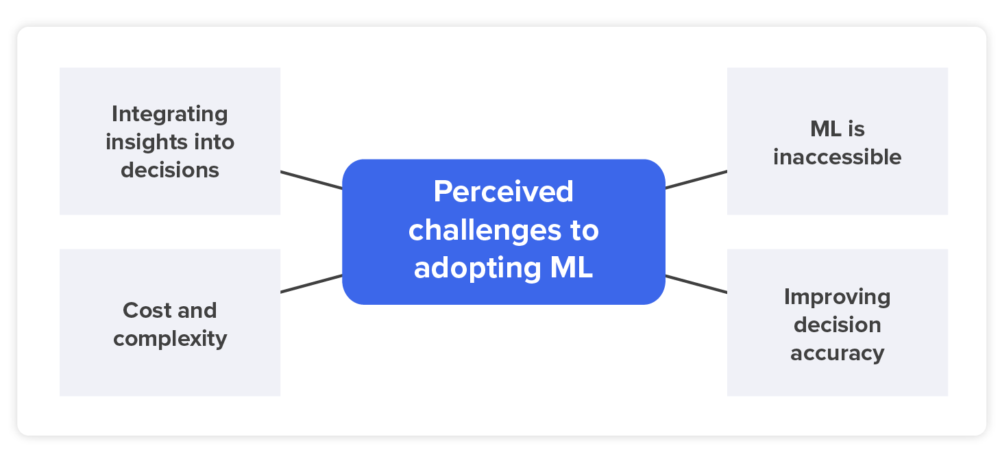Demystifying AI- and ML-based forecasting


Learn about the common misconceptions and barriers corporations have when it comes to adopting artificial intelligence and machine learning-based forecasting.
The terms “artificial intelligence” (AI) and “machine learning” (ML) often bring about split reactions. On one side of the spectrum, there are the proponents eagerly waiting to see how AI and ML can revolutionize our business and the way we operate. On the other side sit the skeptics—those who fear these technologies will eliminate jobs or even bring the grim dystopian outcomes often seen in sci-fi films.
Regardless of whichever side of the debate you fall on, the fact is that AI and ML have arrived. These technologies are no longer a distant future, but a growing part of our lives. For consumers, AI and ML crop up everywhere from self-driving cars to voice recognition or even video gaming.
For businesses, a powerful application is making forecasts. It’s critical to understand how and why these tools can have a positive business impact. Demystifying the role AI and ML play in forecasting is the first step in helping business and IT leaders better harness intelligence as a part of their planning process.
Drawbacks of traditional forecasting
Users across all areas of an organization conduct forecasts. Finance teams generate revenue forecasts reflecting new scenarios, variances, and opportunities so executives can maximize value. Employees across supply chain and human resources need to accurately predict future workforce needs to optimize inventory or staffing levels. Marketing teams leverage forecasting to allocate promotional spending where it will pay off the most.
Regardless of the department, the traditional forecasting process remains the same: a lengthy exercise, conducted by technical specialists who try to glean insights from what’s often a small slice of data. By the time a forecast is handed off to a decision-maker, useful new data may have become available, sending technical teams back to the drawing board to re-forecast a scenario.
This kind of manual process is not conducive to agile decision-making and can often delay critical actions. Luckily, AI and ML can help solve these and more forecasting challenges. However, business leaders seem hesitant. Only a quarter of organizations have adopted intelligent forecasting. Why?

Common misconceptions about AI- and ML-based forecasting
Misconceptions and organizational challenges can get in the way of adopting an intelligent forecasting solution. Below are four of the most common barriers to adopting AI- and ML-based forecasting. In future blog posts, we’ll delve more deeply into each challenge and demystify these impressive but often intimidating technologies.
- Turning insights into decisions. Even with forecasting capabilities on their side, some companies still struggle with making sense of the data and insights they glean from their forecasts. It can be difficult to figure out how to transform insights served up by a forecasting engine into an actionable business plan if an explanation doesn’t exist.
- Cost and complexity. The price tag (actual or imagined) may discourage business leaders from making a purchasing decision. AI/ML platforms may also demand considerable time and effort from IT and data science teams to configure, deploy, and maintain.
- AI and ML are widely inaccessible. Once implemented, an intelligent planning solution may still not be accessible to business users. Some tools require heavy technical involvement to run and interpret forecasts.
- Improving decision accuracy. Updating scenarios and forecasts with real-time data is essential to optimizing decisions. However, siloed functions must be able to collaborate and share forecasting insights to drive the right business decisions.
The power of intelligent planning
So how can AI- and ML-based forecasting help you and your organization? It unlocks intelligent planning. Backed by AI and machine learning, key business decision-makers can independently leverage accurate, future-facing insights.
Intelligent planning demystifies AI and ML forecasting, empowering both planners and decision makers to model multiple scenarios and shape future business outcomes—with a full understanding of commercial, operational, and financial implications of their decisions across any line of business. In 70% of predictions, ML or statistical forecasts are proven to deliver the same or greater accuracy than an expert.

When created specifically with business users in mind, an intelligent forecasting system will not only offer you insights, but help you extrapolate meaning, show you a possible outcome, and provide recommendations on how to proceed. Equipping business users with a full breadth of knowledge allows you to make a highly informed decision, backed by a wide range of historical and external data.
For instance, if a retailer wanted to fine-tune its demand forecasts, AI- and ML-based forecasting would be an ideal option. The company could potentially predict demand for tens of thousands of SKUs over the next two quarters by incorporating both historical data and data attributed to the SKUs. What’s more, by adding specific external data such as weather patterns, the AI-aided forecasting can get specific enough to help predict, let’s say, an uptick in sweater sales because a harsh winter is projected.
When compared to traditional statistical forecasting, ML forecasting capabilities are able to deliver more accurate results. In fact, one study found that AI and ML can help improve demand forecasts by up to 10 to 20 percent. ML-based forecasts are able to incorporate a wide range of both historical and external data that helps deliver a finely tuned prediction, whereas traditional forecasting typically leverage just a slice of internal historical data, which can yield inaccurate predictions.
Moreover, AI and ML can learn from these new datasets over time, providing business users with highly accurate predictions and explanations to help hone their decisions.
Transforming the future of forecasting
The transformative power of AI- and ML-based forecasting is here and ready to help you grow business. It’s time to reframe the way we look at these capabilities, not as complex, inaccessible tools, but ways to put intelligent planning in the hands of business users.
Backed by AI and ML, key stakeholders can take new insights based on the most recent set of data and help strategize their action plan. With less time spent on gathering and interpreting data, you can focus on making the right decision for your business with confidence.
This is the first blog of a three-part series that explores intelligent forecasting tools. In our second blog, we’ll take a deeper look at some of the challenges that business leaders face when adopting an AI and ML-based forecasting solution, and share what types of capabilities are most important to help enterprises easily adopt intelligent forecasting.
For more information, read the PlanIQ solution brief.